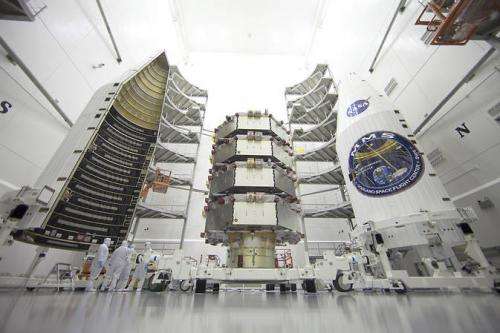NASA spacecraft prepares for March 12 launch to study earth's dynamic magnetic space environment

Final preparations are underway for the launch of NASA's quartet of Magnetospheric Multiscale (MMS) spacecraft, which constitute the first space mission dedicated to the study of magnetic reconnection. This fundamental process occurs throughout the universe where magnetic fields connect and disconnect with an explosive release of energy.
"Magnetic reconnection is one of the most important drivers of space weather events," said Jeff Newmark, interim director of the Heliophysics Division at NASA Headquarters in Washington. "Eruptive solar flares, coronal mass ejections, and geomagnetic storms all involve the release, through reconnection, of energy stored in magnetic fields. Space weather events can affect modern technological systems such as communications networks, GPS navigation, and electrical power grids."
The launch of MMS, on a United Launch Alliance Atlas V rocket, will be managed by the Launch Services Program at NASA's Kennedy Space Center in Florida. Liftoff is targeted for 10:44 p.m. EDT Thursday March 12 from Space Launch Complex 41 on Cape Canaveral Air Force Station, Florida.
The spacecraft will begin science operations in September. Unlike previous missions to observe the evidence of magnetic reconnection events, MMS will have sufficient resolution to measure the characteristics of ongoing reconnection events as they occur.
The mission consists of four identical space observatories that will provide the first three-dimensional view of magnetic reconnection. Because the observatories will fly through reconnection regions in a tight formation, in less than a second, key sensors on each spacecraft are designed to measure the space environment at rates faster than any previous mission.
"MMS engineers have completed final observatory closeout procedures and checks and are awaiting transport to the launch pad tomorrow for integration with the Atlas rocket," said Craig Tooley, MMS project manager at NASA's Goddard Space Flight Center in Greenbelt, Maryland. "The team is in high spirits and ready to get these technological marvels in space."
The mission observes reconnection directly in Earth's protective magnetic space environment known as the magnetosphere. By studying reconnection in this local, natural laboratory, MMS helps us understand reconnection elsewhere, such as the atmosphere of the sun, the vicinity of black holes and neutron stars, and the boundary between our solar system and interstellar space.
"This is the perfect time for this mission," said Jim Burch, principal investigator of the MMS instrument suite science team at Southwest Research Institute (SwRI) in San Antonio, Texas. "MMS is a crucial next step in advancing the science of magnetic reconnection. Studying magnetic reconnection near Earth will unlock the ability to understand how this process works throughout the entire universe."
MMS is led by Goddard, which also built, integrated and tested the four spacecraft. The MMS Instrument Suite Science Team is led by SwRI. The spacecraft are controlled and operated from the MMS Mission Operations Center at Goddard. Science operations planning and instrument command sequence development are performed at the MMS Science Operations Center at the University of Colorado's Laboratory for Atmospheric and Space Physics in Boulder.
Provided by NASA





















